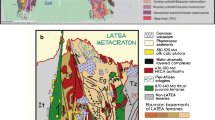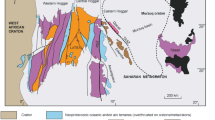Abstract
The paper presents the first data obtained on topaz granites from dikes in columbite-bearing granites of the Kokchetav block, northern Kazakhstan. The columbite-bearing granites (398 ± 3 Ma, Rb-Sr method) compose large massifs and ubiquitously contain columbite as an accessory mineral in amounts from a few to a few dozen grams per ton. The topaz granites make up dikes up to 70–100 m long and 0.4–1.5 m thick, which have sharp contacts with the host granites. The composition of the topaz granites is as follows: albite ∼50%, potassic feldspar ∼24–26%, quartz ∼20%, topaz 3–5%, biotite and muscovite ∼1%. Topaz occurs in inner contact zones in the form of large (3–4 cm) crystals, which grew inward from dike contacts and is ubiquitous in the fine-grained groundmass as small (no larger than 0.05 mm) crystals. The ore minerals in the topaz granites (zircon, thorite, bastnaesite, Y-cerite, monazite, Y-fluorite, W-ixiolite, tantalite, columbite, and uraninite) developed as very small grains, which can be identified only under a microprobe and electron microscope. W-ixiolite was found only in topaz crystals. The topaz granites are rich in albite, contain Na > K and F concentrations from 0.2 to 0.97 wt %. Compared to the host columbite-bearing granites, the topaz granites are 10–15 times richer in Ta and Li, 3-8 times richer in Rb, Cs, Nb, Sn, F, and Be but 1.2–2 times poorer in U, Th, and REE. The columbite-bearing granites have Ta/Nb = 1: 20, while this ratio in the topaz granites is 1: 3, a fact highlighting the enrichment of the granites in Ta and their geochemical autonomy with respect to columbite-bearing granites.
Similar content being viewed by others
References
C. Autrisicchio, C. De Vito, V. Ferrini, and P. Orlandi, “Nb and Ta Oxide Minerals in the Fonte del Plete Granitic Pegmatite Dike, Island of Elba, Italy,” Canad. Mineral. 40, 799–814 (2002).
A. A. Beus, V. A. Severov, A. A. Sitnin, and K. D. Subbotin, Albitized and Greisenized Granites (Apogranites) (Akad. Nauk SSSR, Moscow, 1962) [in Russian].
E. H. Christiansen, D. M. Burt, M. F. Sheridan, and R. T. Wilson, “The Petrogenesis of Topaz Rhyolites from the Western United States,” Contrib. Mineral. Petrol. 83, 16–30 (1983).
P. J. Eadington and B. Nashar, “Evidence for the Magmatic Origin of Quartz-Topaz Rocks from the New England Batholith, Australia,” Contrib. Mineral. Petrol. 67, 433–438 (1978).
A. I. Ginzburg, S. A. Gorzhevskaya, and G. A. Sidorenko, “Tungsten-Ixiolite: A Variety of Ixiolite,” Zap. Vses. Mineral. O-va, No. 1, 63–73 (1969).
J. Haapala, “Magmatic and Postmagmatic Processes in Tin-Mineralized Granites: Topaz-Bearing Leucogranite in the Eurajoki Rapakivi Granite Stock, Finland,” J. Petrol 38, 1645–1659 (1997).
J. Haapala and S. Lukkazi, “Petrological and Geochemical Evolution of the Kymi Stock, a Batholith, Finland,” Lithos 80, 347–362 (2005).
X. L. Huang, R. C. Wang, X. M. Chen, et al., “Vertical Variations in the Mineralogy of the Yichum Topaz-Lepidolite Granite,” Can. Mineral. 40, 1047–1068 (2002).
C. Jahnston and B. W. Chappell, “Topaz-Bearing Rocks from Mount Gibson, North Queensland, Australia,” Am. Mineral. 77, 303–313 (1992).
H. Keppler and P. Wyllie, “Partitioning of Cu, Sn, Mo, W, U, and Th between Melt and Aqueous Fluid in the Systems Haplogranite-H2O-HCl and Haplogranite-H2O-HF,” Contrib. Mineral. Petrol. 109, 139–150 (1999).
D. J. Kontak, “The East Kemptville Topaz-Muscovite Leucogranite, Nova Scotia,” Can. Mineral. 29, 37–60 (1991).
W. T. Kortemlier and D. M. Burt, “Ongonite and Topazite Dikes in the Fluing Wranch area, Tonto Basin, Arizona,” Am. Mineral. 73, 507–523 (1988).
P. V. Koval’, V. I. Kovalenko, M. I. Kuz’min, et al., “Mineral Assemblages, Composition, and Nomenclature of Micas in Rare-Metal Albite-Bearing Granitoids,” Dokl. Akad. Nauk SSSR 202(5), 1174–1178 (1972).
V. I. Kovalenko, “Genetic Problems of Rare-Metal Granitoids,” Zap. Vses. Mineral. O-va, No. 6, 664–677 (1975).
V. I. Kovalenko, Petrology and Geochemistry of Rare-Metal Granitoids (Nauka, Novosibirsk, 1977) [in Russian].
V. I. Kovalenko and N. I. Kovalenko, Ongonites (Nauka, Moscow, 1976) [in Russian].
V. I. Kovalenko, M. I. Kuz’min, Ts. Tseden, and N. V. Vladykin, “Lithium-Fluorine Keratophyres (Ongonites),” in Year-Book-1969 of the Siberian Geochemical Institute (Institut geokhimii SO RAN, Irkutsk, 1970), pp. 85–88 [in Russian].
V. I. Kovalenko, V. V. Yarmolyuk, I. A. Andreeva, et al., Magma Types and Sources in the Earth’s History (IGEM RAN, Moscow, 2006), Vol. 2 [in Russian].
A. V. Krasil’nikova and F. A. Letnikov, “Accessory Minerals of the Granitoids of the Kokchetav Massif,” in Accessory Minerals (Nauka, Moscow, 1968), pp. 315–319 [in Russian].
F. A. Letnikov, “Rare-Metal Granites of the Kokshetau Block,” in Ore-Bearing Granites of Russia and Adjacent Countries (IMGRE, Moscow, 2000).
F. A. Letnikov and Yu. A. Kostitsyn, “Rb-Sr Dating of Anatectic Granites of the Balkashino Complex, Kokchetav Block, Northern Kazakhstan,” Dokl. Akad. Nauk 387(3), 378–381 (2002) [Dokl. Earth Sci. 387, 1035–1037 (2002)].
F. A. Letnikov, “Geochemistry of Granitic Complexes in the Composite Zerenda Batholith, Northern Kazakhstan,” Geokhimiya, No. 7, 691–711 (2005) [Geochem. Int. 43, 627–645 (2005)].
F. A. Letnikov, Granitoids of Blocked Areas (Nauka, Novosibirsk, 1975) [in Russian].
R. V. Masgutov, “Types of Albitized Granites,” Izv. AN Kaz. SSR. Seriya Geol, No. 40, 55–70 (1960).
F. G. Reyf, R. Seltmann, and G. P. Zaraisky, “The Role of Magmatic Processes in the Formation of Banded Li, F-Enriched Granites from the Orlovka Tantalum Deposit,” Can. Mineral. 38, 915–936 (2000).
O. M. Rosen and Yu. A. Serykh, “Migration of Chemical Elements in the Earth’s Crust during Granite Formation,” Geokhimiya, No. 2, 1116–1130 (1970).
K. N. Shatagin, “Disturbance of Rb-Sr Isotopic K-Feldspar System in the Granitoids of the Zolotonoshskii Massif,” Dokl. Akad. Nauk 344, 106–109 (1995).
K. N. Shatagin, “Age and Origin of the Granitoids of the Zerenda Batholith,” Dokl. Akad. Nauk 336(5), 674–676 (1994).
K. N. Shatagin, K. E. Degtyarev, V. N. Golubev, et al., “Vertical and Lateral Heterogeneity of the Crust beneath Northern Kazakhstan from Geochronological and Isotopic-Geochemical Data on Paleozoic Granitoids,” Geotektonika, No. 5, 26–44 (2001) [Geotectonics 35, 356–372 (2001)].
I. C. Stormer, “A Practical Two-Feldspar Geothermometer,” Am. Mineral. 60, 667–674 (1975).
R. P. Taylor, “Petrological and Geochemical Characteristics of the Pleasant Ridge Zinnwaldite-Topaz Granite,” Can. Mineral. 30, 895–921 (1992).
I. V. Veksler and Thomas R. “An Experimental Study of B-, P-and F-Rich Synthetic Granite Pegmatite at 0.1 and 0.26 Pa,” Contrib. Mineral. Petrol. 143, 673–683 (2002).
N. V. Vladykin, Mineralogical-Geochemical Features of Rare-Metal Granitoids in Mongolia (Nauka, Novosibirsk, 1983) [in Russian].
A. V. Voloshin and Ya. A. Pakhomovskii, Mineralogy of Tantalum and Niobium in Rare-Metal Pegmatites (Nauka, Leningrad, 1988) [in Russian].
R. C. Wang, F. Fontan, S. J. Yu, et al., “The Association of Columbite, Tantalite and Tapiolite in the Suzhou Granite, China,” Can. Mineral. 35, 699–706 (1997).
J. D. Webster and C. R. Rebbert, “Experimental Investigation of H2O and Cl Solubilites in F-Enriched Silicate Liquids: Implications for Volatile Saturation of Topaz Rhyolite Magmas,” Contrib. Mineral. Petrol. 132, 198–207 (1998).
B. J. Williamson, C. J. Stanley, and J. J. Wilkinson, “Implications from Inclusions in Topaz for Greisenization and Mineralization in the Hensbarrow Topaz Granite, Cornwall, England,” Contrib. Mineral. Petrol. 127, 119–128 (1997).
S. V. Yudintsev, L. I. Simonova, and E. V. Anokhina, “Tin-Bearing Granites of the Kokchetav Block,” Izv. Akad. Nauk SSSR, Ser. Geol, No. 7, 36–44 (1992).
W. Zhang, R. M. Hua, and R. C. Wang, “Intergrowth of Wolframoixiolite and W-rich Manganocolumbite in Dajishan Tungsten Deposit, Jiangxi Province, South China,” Mineral Deposits [Kuangchuang Dizhi], 2, 158–165 (2003).
Author information
Authors and Affiliations
Corresponding author
Additional information
Original Russian Text © F.A. Letnikov, 2008, published in Petrologiya, 2008, Vol. 16, No. 4, pp. 339–355.
Rights and permissions
About this article
Cite this article
Letnikov, F.A. Topaz granites in northern Kazakhstan. Petrology 16, 319–334 (2008). https://doi.org/10.1134/S0869591108040012
Received:
Published:
Issue Date:
DOI: https://doi.org/10.1134/S0869591108040012




